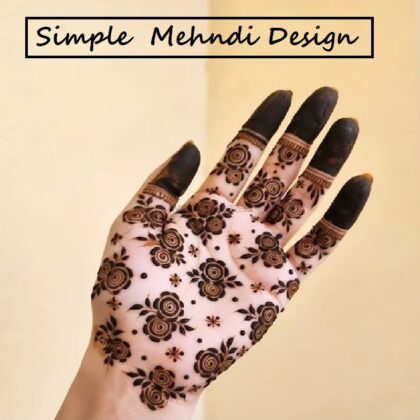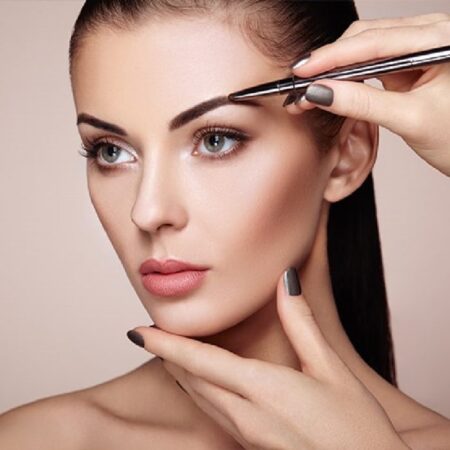
Have you ever rinsed your hair with apple cider vinegar? Are you aware of the benefits of washing your hair with apple cider vinegar? If not, let me enlighten you. Apple cider vinegar (ACV) is a cost-effective, organic, and natural topical treatment for dealing with any kind of skin and hair issues.
A normal scalp has a pH level of 5, which means it is slightly acidic. This level of acidity is important to keep your hair cuticles closed, which maintains the smoothness and shine of your hair. Unfortunately, most hair care products have a pH level above 7, which disturbs the pH balance of your scalp. This is where ACV comes in. It works wonders on your hair by regulating your scalp’s pH level and tackling the ill effects of hair care products that are alkaline. Let’s learn more about the apple cider vinegar hair rinse.
Why Is Apple Cider Vinegar Hair Rinse Good For Your Hair?
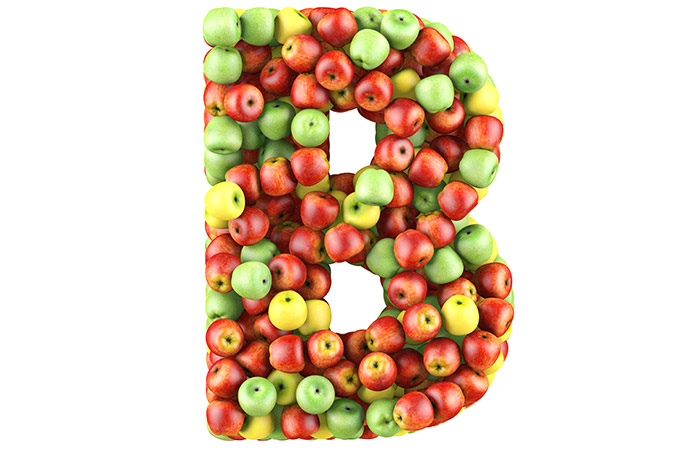
- Since ACV contains a high amount of acetic acid, its pH level is close to that of the human scalp. Washing your hair with ACV helps you maintain the pH balance of your hair and scalp, thereby flattening your hair cuticles and making your tresses smoother, shinier, and healthier.
- ACV is antimicrobial, antifungal, antibacterial, and anti-inflammatory. Rinsing your hair with it regularly helps prevent dandruff, flaking, and hair fall.
- ACV removes the dead skin cells and product residues (like gels, sprays, serums, and hair masks) that are built up on your hair and scalp.
- ACV is comprised of essential nutrients, such as vitamin B, vitamin C, and potassium, which are good for your hair.
- Unlike silicone-based shampoos and conditioners, ACV does not weigh your hair down. On the contrary, it adds volume and body to your hair.
- ACV increases the blood flow to your hair follicles, which stimulates hair growth and strengthens your roots.
- ACV adds luster to your hair, reduces frizz, and lowers its porosity. It also makes your hair more manageable, thus preventing hair breakage and split ends.
- ACV does not contain any chemicals or added preservatives that can damage your hair. It is a cost-effective method of cleansing your hair.
Now that I’ve piqued your interest, let’s talk about how you can make and use an apple cider vinegar rinse.
How To Make And Use Apple Cider Vinegar Hair Rinse
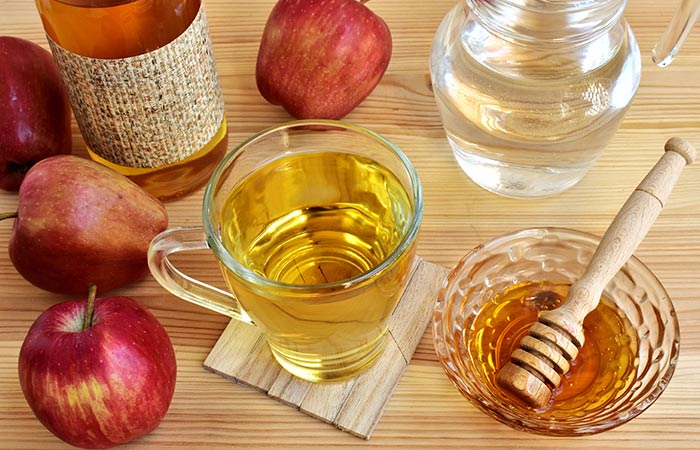
ACV is great for smoothening and strengthening your hair. However, you need to make sure that you are using all-natural apple cider vinegar that has some amount of a sediment called ‘mother’. Commercial clear ACV goes through a heating, distillation, and clarification process that removes the good bacteria, essential nutrients, and living enzymes from it.
The ingredients required to prepare a simple apple cider vinegar (ACV) rinse are as follows:
- 2-4 tablespoons of ACV
- 1 cup (8 oz.) of water
How To Apply
- Mix two to four tablespoons of ACV in one cup (8 oz.) of water.
- After shampooing and rinsing your hair, pour the ACV solution all over your hair and massage your scalp with your fingers. Make sure you cover the entire scalp and all your hair from roots to tips.
- Let it sit in your hair for about 5 minutes before rinsing it off thoroughly.
You can adjust the quantity of ACV to be mixed with water according to your hair type. Dry hair requires two tablespoons of ACV, while oily hair can take up to three to four tablespoons. You can do this rinse once a week or once a month based on your hair’s needs.
To get the most out of your ACV hair rinse, listed below are a few tips that you need to follow.
Tips
- Oily hair and hair with different kinds of scalp issues requires more ACV, while dry hair requires less of it.
- How often you rinse your hair with ACV depends on your hair and scalp condition. Oily hair needs it more often (once every week), while dry hair needs it just once or twice a month. If you have normal hair, do the ACV rinse once every two weeks.
- The ratio and quantity of ACV to water needs to be adjusted according to the length and volume of your hair.
- The best time to prepare the mixture of ACV and water is just before getting into the shower.
- You don’t need to condition your hair after this rinse as ACV is a natural conditioner.
How Often Should I Use The ACV Hair Rinse?
This question can be answered only by you – because it depends on your hair type and what suits it best. Generally, people with dry hair can do it once or twice a month, while people with oily hair can indulge in it more often. Based on the type, volume, and body of your hair, you can determine the intervals at which you want to use an ACV rinse on your hair.
There are a ton of natural ingredients that you can add to your ACV rinse to amp its benefits for your hair. Check them out in the next section!
Other Ways To Make ACV Rinse
1. Essential Oils And Apple Cider Vinegar Hair Rinse
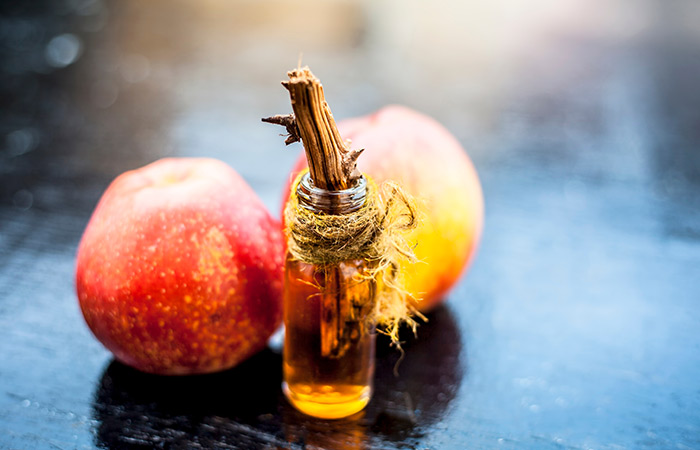
Essential oils offer the same benefits as herbs, but they don’t need to be steeped for two weeks. You need to take a few precautions when storing the ACV and essential oils solution in a glass jar. Also, remember that not all essential oils are safe to be used directly on your hair. Just like herbs, different essential oils have different properties that are beneficial to your hair. Tea tree oil is good for oily hair; cedarwood oil promotes hair growth; geranium oil strengthens your hair; and chamomile oil soothes your scalp and makes your hair silky.
Ingredients Required
- 2 cups of ACV
- 5-10 drops of the essential oil/s of your choice.
Directions
- Mix the ACV and the essential oil/s together.
- Store this mixture in a glass jar or bottle. Do not store it in a plastic container as the essential oils may react with the plastic.
- This mixture can be used instantly. But, if you want to get better results, let it sit for a couple of days.
- When you are ready for the rinse, dilute one to two tablespoons of the mixture with one cup of water.
- Towel dry your hair for best results.
2. Herbs And Apple Cider Vinegar Hair Rinse

You can add fresh or dried herbs to your ACV rinse. Different kinds of herbs offer different benefits. For example, parsley and rosemary augment dark hair; sage can be used to cover gray hair; lavender adds fragrance to your tresses; nettles work well in fighting dandruff; calendula conditions your hair; and chamomile and marigold help in highlighting light brown or blonde hair.
Ingredients Required
For a single application:
- 2-4 tablespoons of ACV
- 2 cups of boiling water with the herbs of your choice mixed in it
For a concentrated mixture:
- 2 cups of ACV
- 1 cup of chopped herbs of your choice
Directions
- Boil the water in a saucepan and add your choice of herbs.
- Allow the herbs to boil for 15 minutes (or more, depending on how strong you want the infusion to be).
- After the infusion cools down, add the ACV and rinse your hair with it. You can use the infusion the same day or refrigerate it for later use.
- For the concentrated mixture, steep the mixture in a tightly closed glass jar and store it in a cool, dark place for two weeks.
- After two weeks, strain the steeped mixture through a coffee filter or a cheesecloth and store it in a fresh bottle.
- When you are ready for the rinse, dilute one to two tablespoons of the steeped mixture with one cup of water.
- If you want extra conditioning, don’t blow dry your hair after drying it. Dry it with a towel.
ACV works like magic when it comes to nourishing, conditioning, and strengthening your hair. So, what are you waiting for? Pamper your hair with an apple cider vinegar rinse and let us know about your experience in the comments section below.

